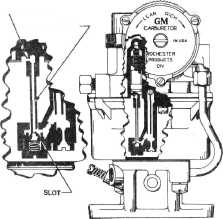|
ROCHESTER CARBURETORS Bulletin 9D-95 February 1953 |
||||
|
ROCHESTER
PRODUCTS
division or GENERAL MOTORS. Rochester,
n. y. |
BULLETIN 9D-95 FEBRUARY, 1953 |
|||
|
|
||||
|
1953 CARBURETOR DESIGN
CHANGES
The
following design changes have been made on Models B, BG. and 4GC Rochester Carburetors
for 1953.
Model B and BC (Chevrolet
Manual and Automatic Choke)
1. The vacuum power piston on all new 1953
Model B and BC Rochester
Carburetors has been redesigned. This new design is referred to
as an "Air Bleed
Power Piston."
Refer to figure 1
The new
power piston differs from the previous design in that it has a hollow stem
which bleeds air into the power valve
of the Main Well Support Assembly whenever the power valve ball check
is off its seat. Air is taken
into the stem through a calibrated hole drilled through the side of the
power piston above the stem. This calibrated air bleed hole is located above the float bowl fuel level
at all times.
In
addition to the hollow stem and air bleed hole, the tip of the power piston stem, which contacts
the power valve ball check, is slotted. This slot permits air to bleed through the hollow stem past
the ball check valve at low manifold vacuums.
The
purpose of the "Air Bleed Power Piston" is simply to decrease the effect
of the metering force upon the power
restriction, thereby supplying correct mixtures at high air
flows.
2. The pump link on new 1953 Model B and BC
Rochester Carburetors is curved to accommodate a Power Glide transmission
function. This new pump link is
grooved to distinguish it from the curved link used on the Model BC Pontiac "6"
carburetors. They are not
interchangeable.
Since the
new curved link is the same length as the straight link used on earlier model
Chevrolet Carburetors it may be used as a replacement part on these earlier models. However, the straight
link must not be used for
servicing 1953 carburetors.
3. All new 1953 Model B and BC carburetors are
calibrated using a square
approach main metering jet.
This change serves to provide the correct mixture in the upper portion of the part throttle
range.
4. It will be noted that the new 1953 model B
and BC passenger car
carburetors incorporate a slotted vacuum spark takeoff hole rather than the
two drilled vacuum holes used on earlier models.
5. No Throttle Return Check Assembly will be
used on 1953 Power Glide cars.
However, both the carburetor
throttle lever and throttle body are designed to accommodate the return check if so
desired.
NOTE:
Since the 1953 Model B and BC caburetors have been completely recalibrated
for use on 1953 engines, they
must not be used to replace previous model carburetors. Always consult
the application index and
parts list for correct service parts and adjustment
information. |

-AIR BLEED HOLE HOLLOW
STEM |
|||
|
Figure I
Model 4GC (Cadillac and Oldsmobile)
1. The 1953 Model 4GC Rochester Carburetor
incorporates a 3/16" higher
fuel level in the Float Bowl
than 1952 models. The purpose of raising this fuel level is to increase the amount of
fuel in the bowl so that when
a tight turn in either direction is being made, the surge of fuel to the side of
the bowl will not uncover or
expose the main metering jets.
The
following changes were made as a result of having raised the liquid fuel level in the
float bowl:
a. The two fuel level sight plugs, located in
the side of the float bowl,
were also raised 3/16".
b. The main discharge nozzle and venturi
cluster assemblies were raised 3/16". This was accomplished by raising the height of the cluster
mounting pads, located in the
float bowl assembly.
c. In order to maintain the proper venturi
relationship, the length
of the secondary venturii located on the venturi cluster assemblies, was
increased 3/16". Thus the
lower or trailing edges of the secondary venturii remain well within the
metering force area of the
large or primary venturii, located in the float bowl
assembly.
d. A newly designed
air horn casting on 1953 model 4GC
carburetors provides relief for the raised venturi cluster
assemblies which protrude a slight distance above the upper surface of the
float bowl casting.
2. The float balance spring and clips assembly
has been removed from all 1953
Model 4GC carburetors.
Accordingly the float hanger support on 1953 air horns will be left undrilled to
prevent confusion in the
field.
3. The change in fuel level and removal of the
float balance springs require
new float adjustment specifications. Using the same method,
gauge, and dimensions for both
1953 Oldsmobile and Cadillac, adjust both sets of floats as
follows: |
||||
|
|
||||
